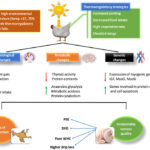Feed evaluation is a critical step in animal nutrition to determine the quality, digestibility, and nutritive value of feedstuffs. Accurate evaluation ensures optimal animal health, productivity, and cost-effective feeding strategies. Various techniques are used for this purpose, including in vivo, in vitro, and in sacco methods, each with distinct advantages, limitations, and applications.
1. In Vivo Techniques
In vivo methods involve feeding trials conducted directly on live animals under controlled conditions. These are considered the most accurate and comprehensive methods for evaluating feed.
Types of In Vivo Trials:
- Digestibility trials: Measure the proportion of nutrients digested and absorbed.
- Balance studies: Assess nutrient retention and excretion (e.g., nitrogen balance).
- Growth and production trials: Monitor weight gain, feed efficiency, milk or egg yield.
- Metabolism trials: Evaluate nutrient utilization and metabolic responses.
Advantages:
- Realistic assessment under natural physiological conditions.
- Measures actual performance and feed efficiency.
- Useful for validating other evaluation methods.
Limitations:
- Time-consuming and expensive.
- Ethical concerns and need for animal welfare protocols.
- Requires sophisticated infrastructure and trained personnel.
2. In Vitro Techniques
In vitro techniques simulate the digestive environment in a laboratory setting, typically mimicking rumen fermentation using buffered rumen fluid.
Common In Vitro Methods:
- Tilley and Terry Two-Stage Technique: Simulates rumen and post-rumen digestion.
- Gas Production Technique: Measures the volume of gas produced as an indicator of fermentation and digestibility.
- Enzyme-based methods: Use digestive enzymes to simulate breakdown of feed components.
Advantages:
- Faster and less expensive than in vivo.
- Requires fewer ethical considerations.
- Useful for screening large numbers of feed samples.
Limitations:
- May not fully replicate the complexity of the animal’s digestive system.
- Results depend on the quality of rumen fluid and laboratory conditions.
- Limited applicability to non-ruminants.
3. In Sacco (In Situ) Techniques
In sacco techniques involve placing feed samples in nylon or polyester bags and inserting them into the rumen of a fistulated animal (usually a cow or sheep) for specific durations.
Procedure:
- Feed samples are ground and sealed in porous bags.
- Bags are incubated in the rumen for different time intervals (e.g., 2, 6, 12, 24, 48 hours).
- Bags are retrieved, washed, dried, and analyzed for undigested residues.
Data Obtained:
- Rate of degradation.
- Extent of digestibility over time.
- Kinetic parameters of ruminal fermentation.
Advantages:
- Provides real-time rumen digestion kinetics.
- Reflects microbial activity and feed-microbe interaction.
- Requires fewer animals than in vivo trials.
Limitations:
- Requires rumen-fistulated animals and ethical approval.
- Limited to rumen degradability; doesn’t assess post-rumen digestion.
- Physical losses from the bags may affect accuracy.
Comparison Table
| Technique | Direct Animal Use | Cost | Accuracy | Speed | Application |
|---|---|---|---|---|---|
| In Vivo | Yes | High | High | Slow | Overall feed evaluation |
| In Vitro | No (uses rumen fluid) | Moderate | Moderate | Fast | Screening feeds, fermentation studies |
| In Sacco | Yes (fistulated animals) | Moderate | High | Moderate | Rumen degradability studies |
Conclusion
Each feed evaluation technique—in vivo, in vitro, and in sacco—offers unique insights into feed quality and digestibility. The choice of method depends on the research objective, available resources, animal species, and ethical considerations. A combination of these techniques often provides the most comprehensive assessment of feed value and performance potential in livestock nutrition.




good deta
Very very informative about vivo vitro and sacco(situ)
Well demonstrated
Wonderful